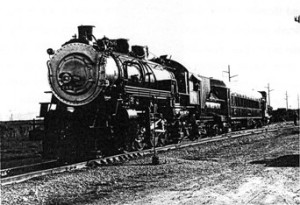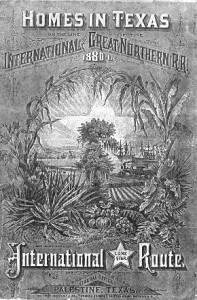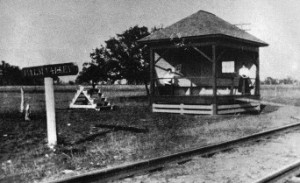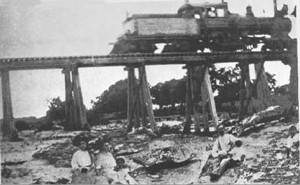The Historic Round Rock Collection
The Railroads of Round Rock
The Historic Round Rock Collection is a project documenting Round Rock’s history, funded in part with a grant from the Texas Historical Commission. These pages are adapted from the original 1991 print version.
The first railroad tracks in Texas were constructed in 1852. By 1870, only 583 miles of track existed, all of it constructed prior to the Civil War. The post-war legislature decided to make railroad construction a priority. A system of land grants was established whereby railroads were induced to construct tracks in return for free land, which they could then sell to the general public for a profit (Pool 164). This land grants system resulted in 17,078 miles of trackage by 1932 and made many railroads quite wealthy (Stephens 51). Additionally, the State could now claim to have a well-integrated railway system, connecting all major cities in the State.

Round Rock can claim that the most significant event in its history was the coming of the railroad in 1876. This event precipitated the relocation of the town’s central business district and changed Round Rock forever.
The railroad responsible for this occurrence was the International and Great Northern (I. & G. N.). The I. & G. N. was incorporated on August 5, 1870 with the intention of constructing a rail line across the State of Texas from the northeast to the southwest. The line was to originate at a point on the Red River, just across from Fulton, Arkansas, and extend southwestward, passing through the cities of Austin, San Antonio and finally Laredo, where it was to cross the Rio Grande and link up with the Mexican National Railroad (Potts 55).
The Texas Legislature took an active stance in the development of the railroad, offering the company State Bonds of $10,000 for every mile of track constructed; the bonds were to have a thirty year lifespan and an eight percent interest rate. The Legislature’s justification for providing this funding was “to secure and promote the rapid construction of said railway, and thereby afford cheap and necessary facilities for immigration into the State.”
Bonds totaling $500,000 were prepared and then signed by Governor E. J. Davis; when they were presented to then Texas Comptroller A. Bledsoe, he refused to register them on the grounds that the law that authorized the use of State funds for the financing of a private corporation was unconstitutional. The matter was resolved in 1875 by the State agreeing to give the railroad twenty sections of land for every mile of track constructed and exempting the railroad from State taxes for a period of twenty-five years (Potts 93-94). The I. & G. N. became the only railroad in the State to be exempted from taxes and to receive land grants without being required to locate and survey an additional section of land for the State for each section the railroad received (Reed 314).

By July of 1876, the rails of the I. & G. N. had reached a point near the existing town of Round Rock but to the southeast of the “Old Town” and Brushy Creek. The railroad purchased 150 acres of land for $3000 from Washington Anderson, retaining twenty-five acres for right-of-way; they sold the remaining 125 acres to the Texas Land Company– an I. & G. N. subsidiary (DiGesualdo and Thompson 70). The Texas Land Company then subdivided this land and the “New Town” of Round Rock began.
As mentioned above, the I. & G. N. was induced to build trackage through the issuance of State land grants. The railroad then sold this land to individuals in order to fund further construction. The I. & G. N. received a total of 6,389,120 acres of State land, which it then sold through its subsidiary– the Texas Land Company– for a total of $4,463,960, averaging out to approximately seventy cents per acre (Handbook of Texas 890). The Texas Land Company published a series of books entitled Homes In Texas On The Line Of The International And Great Northern R.R. in which they advertised land for sale in Texas to residents in the Northeast section of the country.In July of 1876, a “tent city” appeared alongside the newly constructed rails at “New Town” as businesses relocated from “Old Town,” and others, recognizing the opportunities presented by the new rail line, relocated their businesses from Georgetown, the County Seat of Williamson County, to the newly flourishing town of Round Rock (Scarbrough 313). Georgetown civic leaders, desiring to tap into the benefits that came with the railroads, and hoping to avoid being bypassed economically by Round Rock, decided to fund the construction of a rail line connecting their city to the main line 12 miles to the south at Round Rock; thus, the Georgetown Railroad was founded on May 16, 1878.

The Tap Line, as the Georgetown Railroad was often called, was completed in December of that same year, with the first train pulling into Georgetown in mid-December. The sole locomotive owned by the line was a coal burning 4-4-0 named the “J. J. Dimmitt,” after one of the railroad’s founders (“Founding”). The Georgetown Railroad originally had no way to turn the locomotive around once it reached Georgetown, forcing the train to make the return trip backwards. The cars would be placed on a siding while the locomotive was positioned behind them. The train would then proceed backwards, pulling the cars, until it reached the main line at Round Rock, where the locomotive was repositioned at the front of the train and proceeded back to Georgetown in the normal forwards position. To facilitate this process, the “J.J. Dimmitt” was outfitted with cow-catchers and headlamps on both ends (DiGesualdo and Thompson 30).
The Georgetown Railroad offered Round Rock citizens the opportunity to travel to Georgetown for a cost of fifty cents. The train left Round Rock Depot every Sunday morning at nine o’clock in order to allow Round Rock citizens to attend church services at the Chapel at Southwestern University. By the mid 1890s, the train was offering service between Round Rock and Georgetown three times a day (Scarbrough 315-317).
As a financial operation, the Georgetown Railroad was anything but successful. The cost to build the line in 1878 was $60,224, which was funded by the issuance of stocks and bonds; however, the railroad was never able to turn a profit and soon defaulted on its bonds. The line was purchased by the I. & G. N. under foreclosure for $39,392 in August of 1879 (Reed 322-323).
That same year the I. & G. N. constructed a turntable near the Georgetown Depot, ending forever the spectacle of the train backing into Round Rock (Scarbrough 316).

As the Twentieth Century progressed, the amount of rail traffic declined throughout the nation as well as in the State. The Missouri-Pacific Railroad Company (which had acquired the I. & G. N. in 1956) was planning to close the tap line in 1958. That same year, businessmen from Georgetown contacted the Missouri-Pacific about purchasing the line to be used to haul rock from a quarry at Georgetown to Round Rock. Since then the new Georgetown Railroad has operated 12.2 miles of track along Interstate 35 between Georgetown and Round Rock (Handbook Supplement 334).
In the early 1970s, passenger service was revived on the Georgetown Line. On Sundays, the Balcones and Hill Country Passenger Railroad would make eight-mile excursion trips leaving from a temporary station near the Inner Space Cavern. A Georgetown Railroad diesel engine would pull two circa 1920s restored passenger cars, purchased from the Rock Island Line, on a forty minute trip through the Georgetown and Round Rock areas. The Balcones and Hill Country Railroad had purchased and was restoring a steam locomotive that originally saw service on the Moscow-Camden-St. Augustine Line in East Texas. It was hoped that the steam locomotive would be used to pull the passenger cars; however, the steam locomotive was removed to the Texas Transportation Museum in San Antonio and the Balcones and Hill Country Railroad was disbanded (“Passenger” A7).
Today, the railroads, although they no longer stop in the city, continue to have a major presence in Round Rock. The Union Pacific and Amtrak make extensive use of the original I. & G. N. rail lines and the Georgetown Railroad continues to make several runs daily.
Another rail line that played a role in Round Rock’s history was the Missouri, Kansas and Texas (MKT or Katy). The line passed just east of Round Rock through Palm Valley, running in a north-south direction. The line was constructed in 1903, connecting Granger, Georgetown and Austin. The line was closed and most of the tracks were removed in the late 1960s, but the railroad still retains the right-of-way (DiGesualdo and Thompson 72-73). Recently, the State Highway Department has proposed to use the abandoned line to construct a six-lane highway to run north-south connecting the southern parts of Austin to Georgetown.
Works Cited
Digesualdo, Jane H. and Karen R. Thompson. Historical Round Rock. Eakin Publications, Inc. Austin, Texas: 1985.
Eldon, Stephen Branda, editor. The Handbook of Texas A Supplement. The Texas Historical Association, Austin, Texas: 1976.
“Founding of Georgetown Railroad in 1878 Was Momentous Event.” Williamson County Sun. Aug. 1, 1968.
Homes In Texas On The Line Of The International And Great Northern R.R. 1880-1. Matthews, Northrup and Co., Buffalo, New York: 1880.
“Passenger Train Revived.” Austin American Statesman. Nov. 7, 1971: A7.
Pool, William C., maps by Edward Triggs. A Historical Atlas of Texas. The Encino Press, Austin, Texas: 1975.
Potts, Charles S. Bulletin of the University of Texas No. 119. “Railroad Transportation in Texas.” The University of Texas, Austin, Texas: 1909.
Reed, S. G. A History of the Texas Railroads. The St. Clair Publishing Co., Houston, Texas: 1941.
Scarbrough, Clara Stearns. Land of Good Water. Williamson County Sun Publishers, Georgetown, Texas: 1973.
Stephens, A. Ray and William M. Holmes. Historical Atlas of Texas. University of Oklahoma Press, Norman, Oklahoma: 1989.
Webb, Walter Prescott, Editor-in-Chief. The Handbook of Texas. The Texas Historical Association, Austin, Texas: 1952.


